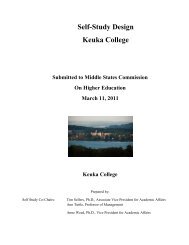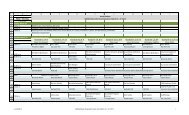final version of the self-study document - Keuka College's Middle ...
final version of the self-study document - Keuka College's Middle ...
final version of the self-study document - Keuka College's Middle ...
Create successful ePaper yourself
Turn your PDF publications into a flip-book with our unique Google optimized e-Paper software.
institutional effectiveness and student learning, including assessment <strong>of</strong> co-curricular<br />
learning activities, to meet our regional (<strong>Middle</strong> States), state (NYSED), and specialized<br />
accrediting requirements across all delivery formats and locations.” The Associate Vice<br />
President for Academic Programs (AVPAP), who reports directly to <strong>the</strong> Vice President<br />
for Academic Affairs, is responsible for coordinating <strong>the</strong> assessment <strong>of</strong> student learning<br />
at <strong>Keuka</strong> College. The AVPAP oversees a prescribed assessment process, requiring <strong>the</strong><br />
submission <strong>of</strong> annual assessment reports each year which he reviews and posts on <strong>the</strong><br />
College Moodle Assessment site.<br />
The first step in an effective student learning assessment plan is clearly articulated goals<br />
at <strong>the</strong> course, program, and institutional levels. Over <strong>the</strong> last 5 years, we have<br />
significantly streng<strong>the</strong>ned our goals across all levels through intentional integration. In<br />
April 2010, <strong>the</strong> <strong>Keuka</strong> College faculty <strong>of</strong>ficially adopted five goals as our institutionlevel<br />
essential learning goals and labeled <strong>the</strong>m our “E-LEAP Goals” (Appendix 4.16 E-<br />
LEAP Definitions). These E-LEAP goals replaced our existing 15 Graduate Outcomes<br />
(<strong>of</strong> which only eight were formally defined and operationalized) that had been in place<br />
for over 15 years. This initiative was lead by <strong>the</strong> “GO Team,” an ad hoc committee on<br />
graduate outcomes (GO), or <strong>the</strong> institutional-level essential learning outcomes. (The ad<br />
hoc GO Team completed its charge at <strong>the</strong> end <strong>of</strong> <strong>the</strong> 2010-2011 academic year.) The E-<br />
LEAP goals are based on <strong>the</strong> four AAC&U “LEAP” essential learning outcomes (see<br />
http://www.aacu.org/leap/ for more information) which are: Knowledge <strong>of</strong> Human<br />
Cultures and <strong>the</strong> Physical and Natural World, Intellectual and Practical Skills, Personal<br />
and Social Responsibility, and Integrative and Applied Learning. The AAC&U Learning<br />
Outcomes were designed around integration with one ano<strong>the</strong>r for both General Education<br />
and <strong>the</strong> programs, and with a “first to last” (freshman to senior) progression, and crossdisciplinary<br />
ideals. <strong>Keuka</strong> added a fifth goal, <strong>the</strong> “E,” for our “experiential education” as<br />
this is our institutional hallmark and is an important method and component <strong>of</strong> student<br />
learning for <strong>Keuka</strong> students. During <strong>the</strong> 2010-2011 academic year, <strong>the</strong> ad hoc GO Team<br />
put toge<strong>the</strong>r an integrated plan for assessment <strong>of</strong> student learning which was approved at<br />
<strong>the</strong> April 2011 faculty meeting, and posted prominently at <strong>the</strong> top <strong>of</strong> <strong>the</strong> Assessment<br />
Moodle site (Appendix 4.17 Assessment <strong>of</strong> Student Learning Plan Diagram).<br />
While <strong>the</strong> new E-LEAP essential learning goals and definitions are new, <strong>the</strong>y are not a<br />
complete departure from our old graduate outcome statements (goals). In two Spring<br />
2010 presentations to faculty, <strong>the</strong> GO Team demonstrated how <strong>the</strong> E-LEAP goals were<br />
aligned to <strong>the</strong> old graduate outcomes as part <strong>of</strong> <strong>the</strong> new adoption process (Appendix 4.18<br />
Alignment <strong>of</strong> New E-LEAP and Old Graduate Outcomes). This alignment procedure<br />
allowed <strong>the</strong> faculty and administration to ensure that we were fundamentally retaining <strong>the</strong><br />
same essential learning goals <strong>of</strong> <strong>Keuka</strong> College, but in a format that was easier for all<br />
constituents (students, faculty, staff, alumni, administration and outside groups) to<br />
understand, articulate, and for faculty and administration to assess. In addition, we<br />
retained five <strong>of</strong> <strong>the</strong> graduate outcome essential learning goal definitions (Appendix 4.19<br />
Existing Graduate Outcome Statements) to better define four <strong>of</strong> our General Education<br />
(Gen Ed) goals. Because E-LEAP assessment is a function <strong>of</strong> both Gen Ed and Program<br />
assessment, it is discussed following both Gen Ed and Program assessment below.<br />
Page 11 <strong>of</strong> 31 Chapter 4: Inst. Effectiveness & Assessment




